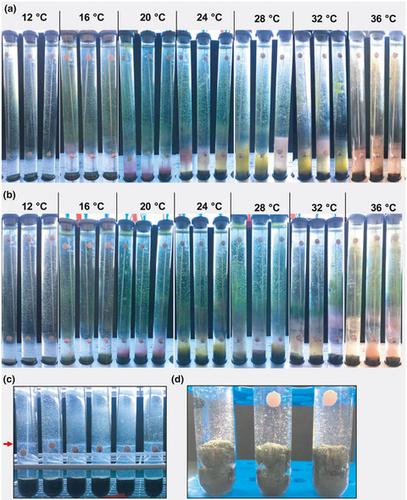当前位置:
X-MOL 学术
›
Microbiologyopen
›
论文详情
Our official English website, www.x-mol.net, welcomes your
feedback! (Note: you will need to create a separate account there.)
Large and interacting effects of temperature and nutrient addition on stratified microbial ecosystems in a small, replicated, and liquid‐dominated Winogradsky column approach
MicrobiologyOpen ( IF 3.9 ) Pub Date : 2021-05-15 , DOI: 10.1002/mbo3.1189 Marcel Suleiman 1 , Yves Choffat 1 , Uriah Daugaard 1 , Owen L Petchey 1
MicrobiologyOpen ( IF 3.9 ) Pub Date : 2021-05-15 , DOI: 10.1002/mbo3.1189 Marcel Suleiman 1 , Yves Choffat 1 , Uriah Daugaard 1 , Owen L Petchey 1
Affiliation

|
Aquatic ecosystems are often stratified, with cyanobacteria in oxic layers and phototrophic sulfur bacteria in anoxic zones. Changes in stratification caused by the global environmental change are an ongoing concern. Increasing understanding of how such aerobic and anaerobic microbial communities, and associated abiotic conditions, respond to multifarious environmental changes is an important endeavor in microbial ecology. Insights can come from observational and experimental studies of naturally occurring stratified aquatic ecosystems, theoretical models of ecological processes, and experimental studies of replicated microbial communities in the laboratory. Here, we demonstrate a laboratory‐based approach with small, replicated, and liquid‐dominated Winogradsky columns, with distinct oxic/anoxic strata in a highly replicable manner. Our objective was to apply simultaneous global change scenarios (temperature, nutrient addition) on this micro‐ecosystem to report how the microbial communities (full‐length 16S rRNA gene seq.) and the abiotic conditions (O2, H2S, TOC) of the oxic/anoxic layer responded to these environmental changes. The composition of the strongly stratified microbial communities was greatly affected by temperature and by the interaction of temperature and nutrient addition, demonstrating the need of investigating global change treatments simultaneously. Especially phototrophic sulfur bacteria dominated the water column at higher temperatures and may indicate the presence of alternative stable states. We show that the establishment of such a micro‐ecosystem has the potential to test global change scenarios in stratified eutrophic limnic systems.
中文翻译:

在小型、可重复且以液体为主的维诺格拉茨基柱方法中,温度和养分添加对分层微生物生态系统的巨大且相互作用的影响
水生生态系统通常是分层的,蓝细菌位于好氧层,光养硫细菌位于缺氧层。全球环境变化引起的分层变化一直受到关注。加深对此类需氧和厌氧微生物群落以及相关非生物条件如何响应多种环境变化的了解是微生物生态学的一项重要努力。见解可以来自对自然发生的分层水生生态系统的观察和实验研究、生态过程的理论模型以及实验室复制微生物群落的实验研究。在这里,我们展示了一种基于实验室的方法,采用小型、可复制且以液体为主的维诺格拉茨基柱,以高度可复制的方式具有不同的含氧/缺氧地层。我们的目标是在这个微生态系统上应用同时的全球变化情景(温度、营养添加)来报告微生物群落(全长 16S rRNA 基因序列)和非生物条件(O 2 、H 2 S、TOC)含氧/缺氧层对这些环境变化做出反应。强烈分层的微生物群落的组成很大程度上受温度以及温度和养分添加的相互作用的影响,这表明需要同时研究全球变化处理方法。尤其是光养硫细菌在较高温度下在水柱中占主导地位,可能表明存在替代稳定状态。我们表明,建立这样一个微生态系统有可能测试分层富营养化湖沼系统中的全球变化情景。
更新日期:2021-05-17
中文翻译:

在小型、可重复且以液体为主的维诺格拉茨基柱方法中,温度和养分添加对分层微生物生态系统的巨大且相互作用的影响
水生生态系统通常是分层的,蓝细菌位于好氧层,光养硫细菌位于缺氧层。全球环境变化引起的分层变化一直受到关注。加深对此类需氧和厌氧微生物群落以及相关非生物条件如何响应多种环境变化的了解是微生物生态学的一项重要努力。见解可以来自对自然发生的分层水生生态系统的观察和实验研究、生态过程的理论模型以及实验室复制微生物群落的实验研究。在这里,我们展示了一种基于实验室的方法,采用小型、可复制且以液体为主的维诺格拉茨基柱,以高度可复制的方式具有不同的含氧/缺氧地层。我们的目标是在这个微生态系统上应用同时的全球变化情景(温度、营养添加)来报告微生物群落(全长 16S rRNA 基因序列)和非生物条件(O 2 、H 2 S、TOC)含氧/缺氧层对这些环境变化做出反应。强烈分层的微生物群落的组成很大程度上受温度以及温度和养分添加的相互作用的影响,这表明需要同时研究全球变化处理方法。尤其是光养硫细菌在较高温度下在水柱中占主导地位,可能表明存在替代稳定状态。我们表明,建立这样一个微生态系统有可能测试分层富营养化湖沼系统中的全球变化情景。











































 京公网安备 11010802027423号
京公网安备 11010802027423号